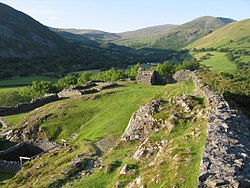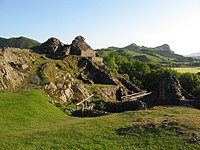Castell y Bere
| Castell y Bere | |
|
Merionethshire | |
|---|---|
 Castell y Bere | |
| Type: | Linear castle |
| Location | |
| Grid reference: | SH667085 |
| Location: | 52°39’29"N, 3°58’17"W |
| Village: | Llanfihangel-y-pennant |
| History | |
| Built From 1221 | |
| Key events: | Welsh Wars Prince Madoc's Rebellion |
| Information | |
| Condition: | Ruined |
| Owned by: | Cadw |
Castell y Bere is a ruined castle atop a hill in the south of Merionethshire. It is to be found near Llanfihangel-y-pennant.
The castle was first built by Llywelyn the Great in the 1220s, a stone castle intended to maintain his authority over the local people and to defend the south-west part of the princedom of Gwynedd. In 1282 war with Edward I of England resulted in the death of Llywelyn's grandson, Llywelyn ap Gruffudd, and Castell y Bere fell to Edward's forces.
Edward I expanded the castle further and established a small town beside it. In 1294 the Welsh leader Madoc ap Llywelyn mounted a major revolt and the castle was besieged and apparently burnt. Edward did not repair it and it became ruined.
Today the castle is in the hands of Cadw and operated as a tourist attraction.
Contents
History
1220-40
Castell y Bere Castle was built in the 1220s by Llywelyn the Great on a rocky hillock overlooking the Dysynni Valley, near Llanfihangel-y-pennant.[1] Few of the Welsh princes built castles in the English style, instead using undefended palaces,[2] but from the late 11th century onwards, the Normans had advanced into Wales, taking lands in the north and establishing a band of territory ruled by feudal lords called the Welsh Marches, and controlled by castles, prompting castle building by the strongest Welsh princes.[3]
Llywelyn the Great initially controlled the princedom of Gwynedd, but grew more powerful over the course of his reign and extended his influence over most of the Wales princes during the early years of the 13th century;[4] this though put him in conflict with the Welsh lords resentful of overlordship and with the King of England concerned at his rising power.[5]
In 1221 Llywelyn took control of neighbouring Meirionnydd from his son, Gruffydd, whom Llywelyn had previously placed in power there. Llywelyn then began to build Castell y Bere in order to control the local population and secure his new southwest border, which included the mountain trade routes between Gwynedd, Powys Wenwynwyn and Deheubarth.[6] Castell y Bere was the first of several stone castles built by Llywelyn and the initial castle consisted of several towers positioned around a courtyard, situated on a rocky hillock in the Dysynni Valley near Cadair Idris.[7]
1240-1300
After Llywelyn's death in 1240, Gwynedd's power declined and many of its eastern lands were taken by Henry III of England in 1247.[8] Llywelyn's grandson, Llywelyn ap Gruffudd, took power in 1255 and imprisoned his brother Owain ap Gruffudd before extending his power across Wales.[8] Llywelyn extended the castle with an additional tower to the south, similar to that built at Dolforwyn, probably in order to provide additional accommodation.[9]
King Edward I finally lost his patience with his troublesome vassal Llywelyn and marched against him, and in 1282 Llywelyn was slain near Builth Wells and his principality forfeit.[10] His brother, Dafydd ap Gruffydd, claimed succession but could not hold and fled south to Merioneth while forces under the command of Roger Lestrange and William de Valence marched from Glamorgan and Shropshire, placing Castell y Bere under siege and taking it on 25 April.[11] Edward deployed 7,000 troops to detain Dafydd who was finally captured and executed in October.[10] A team of five masons and five carpenters, under the command of Master Bertram the Engineer, were left at Castell y Bere to conduct unspecified work after the English army had left.[12]
Edward continued to invest money and time in Castell y Bere; he visited three times in 1284, establishing a small town alongside the castle, possibly just to the east.[13] Walter of Huntercombe was appointed the constable of the castle by Edward in 1284 and spent £47 building a new chamber there, potentially for the king to use during visits.[14] Another £262 was spent between 1286 and 1290, most of this in the year following the revolt of Rhys ap Maredudd.[15] A pair of linking walls to the south tower was probably built around this time, and the external barbican and gate towers may also have been built at this time.[16]
In 1294, however, the Welsh leader Madoc ap Llywelyn mounted a major revolt across Wales.[17] Richard Fitzalan, the Earl of Arundel, was ordered in mid-October to ensure that the castle was secure, but by late October the castle was under siege from Madoc's forces.[18] Robert FitzWalter, the castle's constable, was sent to lead a relief expedition.[19] The final fate of Castell y Bere is uncertain, but it was probably taken by Madoc's forces in late 1294 and subsequently burnt.[20]
14th-21st century
Following Madoc's revolt, Castell de Bere and the new English town were both abandoned.[21] While the castle was well situated, unlike the other new coastal castles built by Edward I it could not be provisioned by sea and as a result did not fit well into his plan for controlling North Wales.[22]
After many years, the site was finally cleared of undergrowth in the 1850s, revealing more of the castle's remains, and the first archaeological investigations were carried out.[23] In 1949 Charles Corbett, the owner of the ruins, placed them into the guardianship of the state.[24]
In the 21st century the site is in the care of Cadw and is protected as a scheduled monument and maintained as a tourist attraction.[25]
Architecture
Today the ruins of Castell y Bere still stand on a rocky outcrop, with protective ditches cut into the stone on the south and east sides.[26] The entrance to the castle lies on the west side, where the barbican, probably built by Edward I, contains two gatetowers, overlooking the stone steps approaching the inner gate.[27] Through the barbican is the castle courtyard, containing a large well and the remains of several internal buildings of uncertain date.[28]
The north tower is an apsidal, or "D-shaped", design that is characteristic of Welsh castles of the early 13th century.[29] Originally it may have contained either a hall or a chapel.[30] What is today the middle tower was originally the southernmost part of the defences, but now leads through the Edwardian ditch yard to the south tower, another apsidal design that once contained spacious accommodation.[31] Both the apsidal towers lacked fireplaces in the main chambers, instead using central heaths to heat the rooms.[32]
Unusually for an early Welsh castle, there is evidence of decorative sculpture, including statues of soldiers, having been built into the castle, along with decorative floor tiles. Castell y Bere is the only castle, other than Criccieth, to display such features.[33] Historian Lawrence Butler considers that the castle has delivered some of "some of the finest stone carving from thirteenth-century Wales".[34]
Outside links
| ("Wikimedia Commons" has material about Castell y Bere) |
References
- ↑ Avent, p.12.
- ↑ Avent, p.3.
- ↑ Avent, p.4.
- ↑ Avent, p.6.
- ↑ Avent, p.7.
- ↑ Avent, p.8; Butler, p.31
- ↑ Avent, p.8.
- ↑ 8.0 8.1 Avent, p.14.
- ↑ Butler, p.32.
- ↑ 10.0 10.1 Avent, p.16.
- ↑ Taylor, pp.62, 76.
- ↑ Taylor, p.76; Avent, p.19.
- ↑ Avent, p.19.
- ↑ Avent, p.19.
- ↑ Avent, p.19.
- ↑ Avent, pp.8-9.
- ↑ Avent, p.19.
- ↑ Avent, p.19; Taylor, p.76.
- ↑ Avent, p.19; Taylor, p.76.
- ↑ Avent, p.19; Taylor, p.77.
- ↑ Avent, p.20.
- ↑ Pounds, p.173.
- ↑ Wynne, pp.105-108.
- ↑ Avent, p.21.
- ↑ Castell y Bere, Gatehouse website, accessed 26 October 2011.
- ↑ Avent, p.37.
- ↑ Avent, p.37.
- ↑ Avent, p.38.
- ↑ Avent, p.38.
- ↑ Avent, p.39.
- ↑ Avent, pp.39-40.
- ↑ Avent, p.40.
- ↑ Davis, p.43; Butler, p.32.
- ↑ Butler, p.35.
Books
- Avent, Richard. (2010) Dolwyddelan Castle, Dolbadarn Castle, Castel y Bere. Cardiff: Cadw. ISBN 978-1-85760-205-0.
- Butler, Lawrence. (2010) "The Castles of the Princes of Gwynedd," in Williams and Kenyon (eds) (2010).
- Davis, Paul R. (2007) Castles of the Welsh Princes. Talybont, UK: Y Lolfa Cyf. ISBN 978-0-86243-970-5.
- Jones, Alan Ffred. (2010) "King Edward' I's Castles in North Wales – Now and Tomorrow," in Williams and Kenyon (eds) (2010).
- King, D. J. Cathcart. (1991) The Castle in England and Wales: An Interpretative History. London: Routledge. ISBN 0-415-00350-4.
- Taylor, Arnold Joseph. (1986) The Welsh Castles of Edward I. London: Hambledon Press. ISBN 978-0-907628-71-2.
- Williams, Diane M. and John R. Kenyon. (eds) (2010) The Impact of the Edwardian Castles in Wales. Oxford: Oxbow Books. ISBN 978-1-84217-380-0.
- Wynne, W. W. E. (1861) "Castell y Bere, Merionethshire," Archaeologia Cambrensis Vol. 16 pp.105-110


